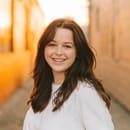As we all know, this past year has been extremely hard for most people. It can be difficult to stay positive and look forward to the future when everything feels so unpredictable right now. Personally, quarantine has been one of the hardest things to adjust to and it can be incredibly isolating when your world becomes virtual and human interaction is limited. Fortunately, there have been a few pros that have come out of quarantine as well, such as having more time to self-reflect.
A few years ago when a global pandemic sounded like something out of a sci-fi novel, our lives were consumed with constant motion. From going to school, to work, to football games and soccer practices, to birthday parties and the movies, we had the option to keep ourselves busy outside our own homes. Though I can admit I took these activities for granted, I am treasuring this time where I am able to slow down, turn inward, and practice some introspection. When we’re constantly moving from one activity to the next, we rarely get the opportunity to reflect on what’s happening on the inside, and sincerely think about what we could personally work on for self-growth. With this self-reflection, I have been envisioning my future, my goals, and the steps I need to take to get there. I started researching ways I could better organize this process for myself, and I was introduced to the world of vision boards.

What is a Vision Board?
A vision board is a tangible collage of your goals and dreams that you can use as a source for inspiration. Susan LaBorde states that “A vision board is a tool used to help clarify, concentrate and maintain focus on what truly matters to you. Literally, a vision board is any sort of board on which you display images that represent whatever you want to be, do or have in your life.” It’s a physical tool that can be used to manifest these goals into reality. They’re also fun to make, and allow you to take some time to not only hone in on what you want to achieve in life, but also get a little crafty.
How to Get Started
For the making of your vision board, I will be using Jean Van’t Hul’s method as a resource. She has been making these for years and claims that this method has worked best for her and others. Feel free to make this process your own, and make adjustments to excite and inspire you, as you see fit.
Step One: Getting Supplies
For the creation of your board, you will need:
-
Poster board or cardstock
-
Magazines or access to the internet to print pictures
-
Markers/Pens
-
Scissors
-
Glue stick
Step Two: Brainstorming Goals
Jean recommends sitting down, and dumping all of your goals onto paper, including, “big goals (get healthy and strong, learn how to meditate, take the family on a trip to St. John) to the little wish list type of stuff (get a new vacuum cleaner), intentions (be more mindful, connect with my family better), and words for the year (clarity, joy, peace).” From this brain dump, prioritize the goals you want to make sure to include, and focus on the goals that matter the most to you.
Step Three: Creating a Structure and Inserting Your Goals
This step is completely optional, but to add a bit more structure to your board, you can divide the poster board or cardstock you’re working with into different life areas you’d like to focus on such as health, family, career, etc. You can do this by just drawing horizontal and vertical lines to create sections. These sections help organize your goals into categories, which can help the overall organization of your board.
After you have created your sections, write in the middle of your squares whatever life area you would like them to represent. You can also assign different colors to your sections to make them more focused and personalized by outlining the border of the sections in different colored markers. After your sections have been labeled and assigned a color, you can now write your goals directly onto the poster board in their corresponding sections/life areas. Don’t worry about how this part looks because you will cover them with pictures later on. This part just helps further develop your goals and can provide more specific ideas when searching for images.
Step Four: Finding Visuals
Once you have all your goals written in the sections they pertain to, you are now ready to start hunting for visuals! You can include anything that you like, but you primarily want to be looking for words and images that correspond with your goals.
If you’re looking through magazines and can’t exactly find what you’re looking for, feel free to look it up! Your board doesn’t have to strictly be images/words from magazines or only from Google, but it can be a mix!
After you’ve found all the visuals you’d like to use, start cutting them out.
Step Five: Arranging Your Board
After everything is cut out, start to place your images/words on your board, inside or close to the section where they belong. Your board should look completely full, and it’s okay not to use all of the pictures you printed. Feel free to save pictures for the next time you build another collage!
After you’ve got the placement of everything you’d like to include just right, start gluing them down. You can also add your own sketches or doodles to your board using markers and sharpies!
Step Six: Putting it on Display
After you’re finished, you’ll want to put your vision board in a place where you can look at it often, and not tucked away into some crowded corner of your room. I have mine on my bulletin board over my desk, forcing me to be reminded of what I’m working towards every day. You’ll want to look at the images/words you’ve included at least once a day to review the goals on your board. This can inspire you to plan time in your schedule to work towards these aspirations and make them become a reality.
I hope you’re able to follow these steps easily and make a vision board that represents who you are and what you want your future to look like! This is just one way to make a vision board and if you’re looking for something a bit smaller or in a different format, there are tons of different resources that can help you create a vision board perfectly tailored to your liking. I can’t wait to make more of these, and am excited to look back on them in the future!


